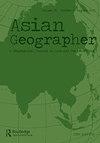印度艾哈迈达巴德的危险产业与分配环境不公
IF 2.2
Q2 GEOGRAPHY
引用次数: 1
摘要
摘要印度城市化的特点是环境质量下降,阶级和种姓隔离加剧。这些趋势表明,有必要分析将环境危害置于城市规模不平等中的分配不公。我们的文章试图通过将被列为重大事故危害(MAH)单位的工业设施的分布与艾哈迈达巴德的社会弱势群体的分布联系起来来解决这一需求,艾哈迈达巴德是印度西部一个有着悠久工业发展历史的大城市。本研究使用双变量统计比较和多变量广义估计方程,检验了在MAH单元密度最高的社区中,社会弱势群体的比例是否过高。我们的统计结果表明,在MAH单位最集中的地区,幼儿、在册种姓和部落以及没有资产和便利设施的家庭的比例明显较高,这是一种分配环境不公正的模式。总的来说,这篇文章展示了印度的城市如何对社会弱势社区造成更大的环境危害,从而引发了人们对其城市化未来的担忧。本文章由计算机程序翻译,如有差异,请以英文原文为准。
Hazardous industries and distributive environmental injustice in Ahmedabad, India
ABSTRACT Urbanization in India has been characterized by declining environmental quality and increasing class and caste segregations. These trends suggest the need to analyze distributive injustices that situate environmental hazards within urban scale inequalities. Our article seeks to address this need by linking the distribution of industrial facilities classified as Major Accident Hazard (MAH) units with the distribution of socially disadvantaged groups in Ahmedabad, a large metropolis in western India with a long history of industrial development. Using bivariate statistical comparisons and multivariable generalized estimating equations, this study examines whether socially disadvantaged groups are overrepresented in neighborhoods with the highest density of MAH units. Our statistical findings suggest a pattern of distributive environmental injustice based on significantly higher proportions of young children, Scheduled Castes and Tribes, and households without assets and amenities in areas with the highest concentrations of MAH units. Overall, this article shows how India's cities pose greater environmental hazards for socially disadvantaged communities, thereby raising concerns about the future of its urbanization.
求助全文
通过发布文献求助,成功后即可免费获取论文全文。
去求助
来源期刊

Asian Geographer
GEOGRAPHY-
CiteScore
3.30
自引率
0.00%
发文量
7
期刊介绍:
Asian Geographer disseminates knowledge about geographical problems and issues focusing on Asia and the Pacific Rim. Papers dealing with other regions should have a linkage to Asia and the Pacific Rim. Original and timely articles dealing with any field of physical or human geographical inquiries and methodologies will be considered for publication. We welcome, for example, submissions on people-environment interactions, urban and regional development, transport and large infrastructure, migration, natural disasters and their management, environment and energy issues. While the focus of the journal is placed on original research articles, review papers as well as viewpoints and research notes under the category of “Asian Geography in Brief” are also considered. Review papers should critically and constructively analyse the current state of understanding on geographical and planning topics in Asia. The ‘Asian Geography in Brief’ section welcomes submissions of applied geographical and planning research about Asia. The section aims to showcase (1) the diverse geography and planning of Asia; and (2) the diverse geographical and planning research about Asia. The journal will also publish special issues on particular themes or areas. Book reviews can be included from time to time.
 求助内容:
求助内容: 应助结果提醒方式:
应助结果提醒方式:


